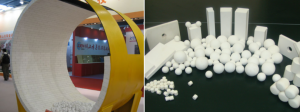Zirconium oxide beads (referred to as “TZP” zirconium beads) are first made of micron and sub nanometer sized raw materials using advanced technology, and all technical indicators and properties have reached international advanced levels. Mainly used for ultra-fine grinding and dispersion of materials that require “zero pollution” and high viscosity and hardness, such as electronic ceramics, magnetic materials, zirconia, silicon oxide, zirconium silicate, titanium dioxide, pharmaceutical and food, pigments, dyes, inks, and specialty chemical industries. Generally used in sand mills, the main grinding medium for fine grinding is zirconium beads with different diameters selected according to the production requirements.
After selecting zirconia beads, how to use them correctly, avoid breakage of zirconia beads, and try to extend the service life of the grinding medium and the contact parts of the sand mill.
Reasons for the formation of broken beads:
The current popular production processes for glass beads, zirconium silicate beads, and pure zirconium beads in the market are basically electric melting method and sintering method. Beads are formed in hot air, cold air, or electrolyte, as in a critical technology
If the parameters are not properly controlled, the following fragile beads will be generated:
1.1 Bubble Beads
1.2 Snowman beads
1.3 Tail Beads
1.4. Flat (elliptical) beads are broken, so when choosing beads, it is important to avoid such beads as much as possible.
Due to the presence of stress concentration areas in the above beads, it is easy to clean the machine with low viscosity liquids during grinding, and the beads will wear out the contact parts of other beads or grinding machines.
To achieve the longest service life of grinding beads and sanders, it is best to use resin for cleaning and maintain sufficient material viscosity during the production process.
Firstly, identify the appearance of “broken beads”, if the particles are relatively smooth, rather than having sharp edges (like broken glass pieces) It is a naturally worn bead. These beads may be ground into various shapes such as discs, ellipses, or reduced spherical shapes, which is called wear, with the difference being only the degree of wear. If the machine is cleaned with a low viscosity liquid, the beads will wear out the contact parts of other beads or sanding machines. To achieve the longest service life of grinding beads and sanders, it is best to use resin for cleaning and maintain sufficient material viscosity during the production process.
From the perspective of force, when the dispersing disc transfers energy to the beads, if the liquid viscosity is low (such as when using solvents or water to clean the sand mill) and the material thrust is not large enough, the beads are likely to come into contact with the dispersing disc and cause breakage. This is also an important reason why we recommend shortening the cleaning time as much as possible. Many people encounter broken beads after pouring old beads into new ones for testing. Below is an analysis of this problem and a discussion of solutions:
1. Improper installation of internal contacts in the sand mill, loose dispersion discs or sharp edges on the dispersion discs, foreign objects inside the sand mill, loose valves, etc., all of which may cause the grinding beads to break.
2. The contact parts of the grinding machine are worn or not installed correctly. The dynamic separator or screen is worn out, and if the screen is broken or reversed, it can cause the grinding medium to pass through the separator and enter the feeding pump. This way, the pump will crush the beads before being blocked or stopped.
3. Back pressure
When the feeding pump is turned off, the residual pressure in the sand mill presses the beads into the pump, so that when the pump starts again, it will crush these beads. A one-way valve may not be reliable and sometimes allows beads to pass before the valve is closed.
4. Grinding bead backlog
The accumulation of grinding beads at the bottom of the sand mill and the excessive speed of the working pump can cause the grinding beads to concentrate at the outlet of the horizontal sand mill, leading to the crushing of the grinding beads. But by starting the sand mill in an “on off on off” jog mode and loosening the accumulated grinding beads, this situation will not occur.
5. Scattering disc wear
There are many reasons that can lead to this situation, so it can be difficult to determine the cause. The edge of the dispersion disk has the highest rotational speed, and if the edge of the dispersion disk is ground unevenly, it is highly likely to form strong eddies. In addition, for vertical grinders, the grinding beads will concentrate near the edge of the lower part of the loose plate due to their own weight.
The excessive wear of the dispersing disc is largely caused by the slow speed of the feeding pump and the high density of the grinding beads. Generally speaking, we can solve this problem by replacing severely worn components and then loading the same batch of grinding beads.
6. Mixing grinding beads produced by different manufacturers
Generally speaking, the density of products from different manufacturers varies. If grinding beads produced by different manufacturers are mixed, it will exacerbate mutual wear between the beads.
7. Add used old beads to the sander
Obviously, doing so will also exacerbate the mutual wear between the beads, thereby affecting their service life.
Post time: Aug-26-2023





